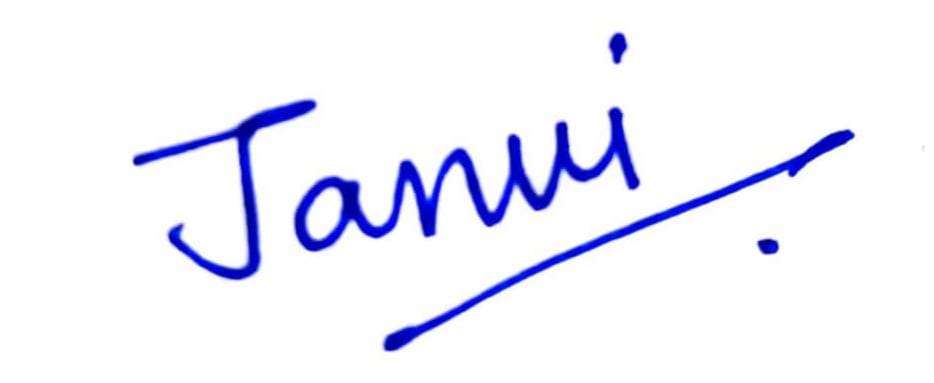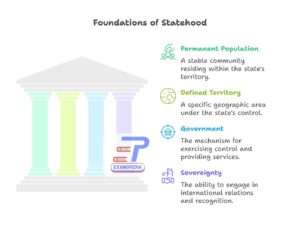1. State as Actors
1.1. Elements of Statehood:
2. Crisis for Territorial State
3. Non-State Actors
3.1. 1. Multinational Corporations (MNCs) and Transnational Actors (TNCs).
3.2. 2. Inter-governmental Organizations (IGOS)
3.3. 3. International Non-governmental organizations
3.4. 4. Religious Non-State Actors
3.5. 5. Fundamentalist and Terrorist Groups
3.6. 6. Global Media and Communication Networks
4. Increasing role of Non-State Actors
5. Significance of State’s role in IR
6. Conclusion

Hey champs! you’re in the right place. I know how overwhelming exams can feel—books piling up, last-minute panic, and everything seems messy. I’ve been there too, coming from the same college and background as you, so I completely understand how stressful this time can be.
That’s why I joined Examopedia—to help solve the common problems students face and provide content that’s clear, reliable, and easy to understand. Here, you’ll find notes, examples, scholars, and free flashcards which are updated & revised to make your prep smoother and less stressful.
You’re not alone in this journey, and your feedback helps us improve every day at Examopedia.
Forever grateful ♥
Janvi Singhi

Give Your Feedback!!
Topic – State and Non-State Actors (Notes)
Subject – Political Science
(International Relations)
Table of Contents
- The structure of the present-day international system is quite complex and is increasingly becoming more intricate due to changes in the nature of its component units.
- Traditionally, only states were considered the primary actors of the international system, but now there is increasing recognition of non-state actors in international relations.
- The international system can thus be seen as combining several kinds of actors with varying degrees of autonomy, with states retaining a leading, but not an exclusive, role.
- Some scholars define the international system as a complex network of states and other actors interacting with each other.
- A system is defined by the attributes of its components and the nature, pattern, and number of interactions among them.
- When applied to the international system, important factors include the number of state actors, the relative size of various actors, the number and types of non-state actors, the linkages or interactions among states, and the interdependence among units.
- As Frankel points out, the international system lacks two prerequisites of domestic political systems: a social basis of community and a political structure of government.
- The international system does not have any unconditional agreement on cooperation or on the precedence of common good over individual or subgroup interests. It is built only on limited and conditional cooperation, which sometimes degenerates into anarchy.
- In the absence of a hierarchically arranged government, there is no authority to determine the jurisdiction of all social sub-groups or enforce norms and laws. What exists is a loose structure and weak sets of norms regulating state behaviour.
- The international system is characterized by the presence of sovereign states, anarchy, security dilemmas, balance of power, hegemony, alliances, regional alignments, international regimes, collective security, conflict, and conflict resolution.
- Currently, the contemporary international system faces an increasing crisis of territorial states vis-à-vis the challenges posed by non-state actors.
State as Actors
- The concept of ‘state’ is very important in the study of International Relations (IR).
- Traditionally, IR deals with the interaction among independent sovereign states.
- As the most important political institution in society, the state has always attracted the attention of scholars from ancient times to the present.
- The state has been analysed from different, sometimes contradictory perspectives, but its basic identity has largely remained unaltered.
- A state is a definite geographical territory comprising people who are politically organized and obey its authority.
- The modern idea of the nation-state emerged from the Treaty of Westphalia of 1648, which organized political units in Europe based on language. These units gradually came to be known as nation-states.
- The period 1450–1650 marked the evolution of the territorial state system, culminating in the Westphalia Treaty, which ended the Thirty Years’ War in Europe.
- The treaty established the principle that “the ruler of the territory would determine the religion of that territory”, dispersing authority among kings and princes and laying the foundation for sovereign nation-states.
- From this period onwards, the key elements of statehood—people, territory, government, and sovereignty—were formally conceived.
- The government is considered the agent of the state, representing its authority and sovereignty in both domestic and international contexts.
- Over time, the state system evolved due to an increase in the number of states, interdependence in economic, technological, and political spheres, growth of democratic institutions, international law, regional alliances, and developments in military warfare.
- Scholars like Palmer and Perkins assert that while the state-system may be changing, its basic design persists: coexistence of multiple states, some being major powers, all subscribing to sovereignty and seeking to develop national power.
Elements of Statehood:
The Montevideo Convention on the Rights and Duties of States (1933) is often cited as a codification of customary international law regarding the criteria for statehood. According to the convention, a state should possess the following qualifications:

1. People:
A state must have a population that resides within its territory on a permanent basis. There is no minimum or maximum size requirement for the population. What matters is the existence of a stable community of people. This population provides the human resources necessary for the state to function. Beyond mere numbers, the quality and character of the population—such as literacy, health, skills, age distribution, productive capacity, customs, and moral values—determine the strength and functionality of the state. For example, Japan has a relatively small population compared to India, but its highly skilled, educated, and disciplined workforce has enabled it to become a major economic power. Similarly, high national morale and social cohesion strengthen the state internally and enhance its capacity to project power externally.2. Territory:
A state requires a fixed geographic area over which it exercises undisputed authority. The size of territory is less important than strategic location, defensibility, and natural resources. The boundaries of the territory do not need to be perfectly defined or undisputed. However, there must be a core area that is clearly under the state’s jurisdiction. Territory includes land, water (internal waters and territorial sea), and airspace. For instance, Great Britain, despite being an island of modest size, dominated global trade and colonies for centuries due to its strategic position and strong navy. The United States benefited from its geographic isolation and vast territory, allowing it to adopt periods of isolationist foreign policy while remaining secure. Territories also provide resources, economic opportunities, and military depth, which are crucial for national power and foreign policy.3. Government:
A state must have a government that is capable of exercising effective control over its territory and population. The government is the mechanism through which the state’s will is formulated and implemented. The form of government can vary widely, from democracies to autocracies, but it must be able to maintain order, enforce laws, and provide essential services. The government is the political organization through which the state expresses its will, implements policies, and exercises authority. A state without a recognized government cannot effectively act internationally. For instance, the People’s Republic of China was not recognized by the United States or many Western nations until 1971; until then, it could not fully participate in international diplomacy. Governments translate the sovereign will of the state into action—whether in diplomacy, security, or economic policies—and their effectiveness directly affects the state’s strength and international standing. The government is considered the agent of the state, representing its authority.4. Sovereignty:
Sovereignty is the supreme authority of the state to govern its territory and population without external interference. It has two dimensions: internal sovereignty, which ensures that no authority within the state can override the government’s control, and external sovereignty, which guarantees independence from other states. This element refers to the state’s ability to engage in diplomatic relations, negotiate treaties, and participate in international organizations. It implies recognition by other states as a sovereign entity. For example, India exercises internal sovereignty through its governance structures and legal system, while external sovereignty allows it to make independent foreign policy decisions without coercion. Sovereignty can be limited by treaties, international law, and participation in organizations like the United Nations, but it remains the foundation of the state’s identity and legitimacy in international relations.- Additionally, the modern state has: legal continuity of the national society, institutionalized agencies and social changes, law-enforcing agencies, defence against external or internal threats, and economic sustenance for its population.
- The state exercises sovereignty exclusively over its territory and people, and is recognized by all other states in the international domain.
- Even with globalization, the state remains the primary and conventional political unit in international affairs.
- The international system is a structured pattern of behaviour among different states based on certain rules and mechanisms of interaction. The extent of influence in international politics varies among states.
- The most powerful nation exerts enormous influence on international issues and tries to manoeuvre situations in its favour.
- Only a few states possess strong economies, powerful militaries, sufficient territory, and adequate industrial and technological infrastructure to exert influence beyond borders.
- Such states are referred to as Great Powers.
- Historically, great powers shaped the international order through economic and political power, alliances, colonial hegemonies, wars, and religious aggressiveness.
- Before World War II, European states like Britain, France, Germany, Holland, Spain, and Portugal were great powers shaping international politics.
- The war weakened these powers, reducing their influence.
- After the war, USA and Soviet Union emerged as superpowers exerting global influence.
- Their ideological and political rivalries divided the world into two camps, a situation known as the Cold War.
- The collapse of the Soviet Union marked the end of the Cold War.
- In the post–Cold War period, the US remained the only superpower with sufficient economic and military strength.
- The US now attempts to be the prime controlling power in international politics.
- Historically, states dominating international relations have always been the great powers.
- Presently, the world economy is dominated by a few rich states with substantially high GDPs.
- US, Japan, France, Britain, China, Germany, and Russia account for about half of the world’s GDP.
- The concentration of economic power and subsequent political clout in these states gives them superiority in world politics.
- These states are important actors influencing and dominating IR.
- Besides great powers, medium and small powers also play significant roles in world politics.
- The smooth functioning of the international system relies on interdependence and interplay among all states.
- Despite several challenges such as scientific and technological development, information revolution, globalization, expanding arms market, and increasing significance of multinational companies and NGOs, the state maintains its key position in contemporary international politics.
- The state continues to be the primary actor, shaping international norms, security frameworks, and economic interactions.
- The nation-state remains the foundation of sovereignty and international legal recognition.
- Its role as a political, economic, and military actor ensures the stability and structure of the international system.
- The influence of the state is reinforced by its institutional capacities, defence capabilities, and ability to enforce laws internally and project power externally.
- Great powers historically and presently set the agenda for international policies, alliances, and global governance mechanisms.
- Medium and small powers contribute to regional stability, collective security, and international cooperation.
- Overall, despite global challenges, the state remains central to understanding international relations and the functioning of the international system.
International Relations Membership Required
You must be a International Relations member to access this content.
